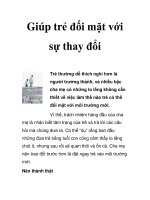1993 chương trình viện trợ của canada ở angola phải đối mặt với những vấn đề lớn
Bạn đang xem bản rút gọn của tài liệu. Xem và tải ngay bản đầy đủ của tài liệu tại đây (1 MB, 3 trang )
Canadian
aid
program in
Canadian aid prograin in
Angola faces huge problems
Frank Timmermans, MB, BS, FRCSC, FACS
A s you walk up the wellworn path through the
open African field, it becomes obvious that the six-storey
building at the top of the hill is a
hospital. Used medical supplies,
gloves, broken syringes and the
occasional medical record litter
the field. Travel the same path at
night, and you hear rats scatter for
their holes. In the driveway at the
hospital's front door stands a
large, open garbage container
overflowing with waste. Small
boys with sticks can often be seen
busily sorting through the garbage,
seeking interesting prizes such as
catheter bags and gloves. Closer to
the hospital, rubbish can be seen
hanging from the wide window
ledges - a clue to one of the more
common disposal methods. And
in a grove of Australian gum trees
beside the hospital, a dilapidated
yellow stucco building is often the
source of the eerie wailing that
means death. This is the morgue.
I went to Lubango, Angola, in
October 1991 to participate in a
Canadian aid project that was designed to train local physicians to
be good generalists, with skills in
surgery, obstetrics, medicine and
community medicine. Lubango, a
city in the southern part of Angola, has about 180 000 residents.
The project was the combined
formed the hub of the academic
program.
Angola was in considerable
turmoil during our visit, but at
least there was a cease-fire in the
16-year civil war while preparations were being made for a supervised election. The MPLA, a
communist party with strong ties
to Cuba and the former Soviet
Union, was in power. The opposition was provided by UNITA, a
guerrilla group backed by the
United States and South Africa.
(Since my visit, elections have
returned the MPLA to power. Although they were deemed fair,
and UNITA has enough seats to
provide effective opposition, its
leader is unhappy with the results
and there is now a real threat of
renewed guerrilla warfare.)
In 1991, the streets were safer
than they had been in years, but
the countryside, littered with
countless unexploded bombs and
land mines, continued to take
its toll. Lubango was one of the
country's more secure areas.
One of the most striking
things about Angola, and something it shares with many developing countries, is the authoritarian,
obstructionist bureaucracy. Third
World bureaucrats often see their
jobs not as positions of responsibility or public service, but as
positions through which power,
no matter how fickle or frivolous,
must be exercised. Contracts are
often worthless, appointments and
timetables impossible, and successful, long-term planning rare.
Many people in these countries
accept such abuses: they expect
nepotism, kickbacks, featherbedding and theft to be part of the
system, and are usually right.
This means that something as
simple as buying a bicycle for a
local church is a transaction
fraught with difficulty, and that
bringing a shipping container into
the country is nearly impossible.
If it somehow passes through the
bureaucracy, it almost certainly
effort of various nongovernment
organizations. The Canadians
were allocated a ward in the Soviet-built Central Hospital and it,
along with the Outpatient Department and several outreach clinics,
Frank Timmermans is a general surgeon
practising in Whitehorse, Yukon.
MARCH 15, 1993
An OR in Angola: The conditions
were
appalling
CAN MED ASSOC J 1993; 148 (6)
1007
will not escape the thieves. In this
situation, the foreigner or aid
worker who has only average perseverance can be expected to
throw up his arms in despair and
leave, vowing that all aid is a
waste!
There are, however, local people who are honest and anxious
to see change and improvement in
society. They work against incredible odds. The project director Angola's only otolaryngologist
and the staff physicians seemed to
have endless patience and perseverance as they waded through the
bureaucratic and political quagmire. Such patience had to be in
abundant supply for those of us
used to Western democratic institutions and who were now trying
to work in Angola's health care
system.
The six-floor Central Hospital
in Lubango is vast and empty.
The wide hallways are lined and
tiled with marble slabs from the
coast; the style is distinctly Soviet.
I was told that people avoid the
hospital; once inside, it was not
difficult to see why. The smell of
urine is everywhere, but is particularly overwhelming in the stairwells.
The Emergency Department
is often empty. There is a treatment room with a bare metal
operating table, several other
completely empty rooms of indeterminate purpose, as well as a
six-bed ward. The ward smells.
There is dried blood and vomit on
the floors, and the mattresses are
more stained and dirty than can
be imagined: it takes a strong
stomach to examine a patient on
one of these beds. There are no
pillows, and no linen of any kind.
Sterility, let alone cleanliness, is
unheard of here. The only medical
equipment is a few random packets of sutures in a plastic bag and
some basic instruments in a boiler. The staff, in contrast, are wonderfully turned out in fresh white
starched and ironed uniforms.
Such paradoxes are common and
always striking.
There was never any water
available above the bottom floor,
and the electrical supply was often
interrupted. There were two new
Soviet diesel generators, but the
equipment and experts needed to
hook them up were not available.
Water arrived on the fourth floor
through a hose passed up the outside of the building, through the
offices and down the hallways,
where it was used to fill drums on
the ward. That water was used for
drinking, occasional toilet flushing, and sometimes to wash
hands.
On the teaching unit, conditions were equally primitive. The
WTT
dt,
The scene outside the front door of Central Hospital
1010
CAN MED ASSOC J 1993; 148 (6)
windows were unscreened and
flies were everywhere; at night
they were replaced by malaria-carrying mosquitoes. There were the
ubiquitous dry, and sometimes
not so dry, secretions on the
floors. Patients often had stale
food beside their beds and the
smell of urine and vomit were at
first overpowering. After 1 month
or so the smells no longer seemed
so pervasive, and I am sure that
after 2 months they would have
seemed quite normal.
The supply of drugs and
equipment on the wards was pitifully small, but far in excess of
what was available in the rest of
the hospital. All plastic syringes
and needles were reused after
boiling. Even with the high incidence of HIV disease, no effort
was made to rinse them with
bleach and the hazard faced by
patients and nurses was clear.
Eventually we managed to secure
a bottle of household bleach from
Namibia so that the syringes
could be rinsed before being disassembled and boiled. Even that
effort will probably not last.
No narcotics were available
- apparently they could not be
imported into the country. The
management of pain, particularly
for surgery or changing burn
dressings, was dreadfully inadequate. The aid project used a general operating suite; a dedicated
operating room in which better
standards could be set had been
promised but had not yet materialized because of the usual bureaucratic hurdles and power
struggles.
Operating conditions were
appalling. Water and electricity
supplies were often interrupted.
The rooms were filthy. The corrugations in the foot pedal of the
primitive cautery device were
obliterated by dried blood. Instruments were selected from bulk
tins in which they had been piled
at random. We wore the same
gowns for the whole list of patients and the operating tablesLE 15 MARS 1993
two to a room - were either bare
metal or covered with a ragged
gown, one too ragged to wear. The
project had provided its own linen, but this had gone the way of
all such things in Angola, and
probably ended up on the black
market.
Patients were walked in to the
operating room and when they
arrived for surgery were naked, or
nearly naked; it was clear that
surgery was a truly frightening
event. After surgery, they were
wheeled out on a bare tin trolley
to the "recovery room," where
they would be left alone on filthy
mattresses to recover without observation, oxygen, suction or any
of the basic things a Canadian
doctor takes for granted.
There was one Russian anesthetist at the hospital, although
nurse-anesthetists did most of the
work. No premedications were
used, and only three intravenous
drugs - diazepam, sodium pentothal and ketamine hydrochloride
- were used. There was no oxygen or nitrous oxide. For infants,
a halothane-soaked gauze was
often held over the face to augment anesthesia. Unfortunately, it
seemed to have much the same
effect on surgeons as infants!
No anesthetic record was kept
and no vital signs were taken. The
patients were not accompanied by
their records and wore no identification. The potential for a wrong
operation was ever present - indeed, I can tell a personal story of
such a disaster.
The infection rate after surgery was so high that I believed
surgery should only be performed
to avoid clear and imminent danger. Simple procedures could turn
into nightmares soon after the operation, and this fact proved almost unbearable for a fastidious
surgeon used to Canadian standards. That any patient here could
successfully undergo surgery and
live through its sequelae is a tribute to man's ability to survive.
If conditions at the Central
MARCH 15, 1993
Hospital were bad, those at the
Maternity Hospital in Lubango
were even worse. Its reputation
for maternal and infant death
made it an object of fear. The first
two women I saw in consultation
were completely naked when
brought into the room. They lay
on a filthy tin table. The only light
was provided by the window.
There was no speculum; I was
grateful for the gloves I had
brought with me. The first woman
had a massive fixed carcinoma of
the cervix, the second a two-finger
vesicovaginal fistula. There was
no sink, no water, no way to clean
up. The women left as they had
come, somehow preserving their
dignity.
Hospital care in the two Lubango hospitals was much the
same as in those in the capital,
Luanda. It is the worst care I have
seen in any Third World country.
Even allowing for the shortages of
equipment and supplies, it was
much worse than need be. Simple
reorganization, some attempt at
cleanliness, and'even a slight reduction in political and bureaucratic obfuscation could make an
enormous difference. I believe the
situation reflects the government's
and health authorities' monumental lack of interest in improving
the standard and availability of
health services in Angola. Given
that lack of interest, how could
even a modest foreign-aid program hope to succeed?
The. Lubango project was
beset with difflculties from the
start. The Angolan government
had ignored its previous commitments, particularly its promise to
provide some funding. There were
endless difflculties at the Central
Hospital, which seemed to revolve
around resentment of the Canadians because they seemed to have
access to more equipment and
drugs and better housing and
transport. The first group of student interns complained that they
had no housing or transport. They
had been provided with hotel ac-
commodation that was a 1 0-minute walk from the hospital. Often,
they simply did not turn up
for scheduled classes. They were
incredulous when I and other physicians told them that in Canada,
most interns find their own housing and transport and work much
longer hours.
Rather than considering
themselves postgraduate students,
they viewed their appointments in
the same way that Angolan civil
servants seem to regard theirs.
The program was seen as a step up
the ladder, and therefore should
be accompanied by more pay,
privileges and perks and less responsibility and work. Even mild
criticism was taken as a personal
affront, and all but one of the six
students resigned shortly after the
course started.
Despite these problems, new
students have been recruited
those with church connections
and a more altruistic outlook
seemed ideal - and the aid project limps on. Who can argue with
the project's goal of training students in their home countries
under the circumstances they will
encounter once they graduate?
For me, the Lubango project
again brought home very strongly
the difficulties faced by people in
the Third World. They cannot
improve their own lot simply by
relying on haphazard handouts
from the rest of the world. First,
they have to overcome the internal power struggles that begin at
the top and always have as their
aim the self-aggrandizement and
enrichment of one group or person. The connection between true
cooperation and a healthy successful society needs to be made.
Trying to build a health care
system in Angola is a daunting
task. Ordinary Angolans, and especially the long-suffering women
and children, are probably justified in viewing illness with a stoic
fatalism, and the general situation
with a sense of resignation and
hopelessness.CAN MED ASSOC J 1993; 148 (6)
1011









